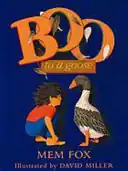Boo to a Goose
Boo to a Goose is a 1996 children's picture book by Australian author Mem Fox, and illustrated by David Miller. In this book, published by Hodder and Stoughton Children's Books, a boy states twelve nonsensical things he would rather do than say "boo to a goose".[note 1]
 | |
| Author | Mem Fox |
|---|---|
| Illustrator | David Miller |
| Cover artist | D. Miller |
| Country | Australia |
| Language | English |
| Genre | Children's picture book, fiction |
| Published | 1996 (Hodder Children's Books) |
| Media type | Print (hardback) |
| Pages | 32 (unpaginated) |
| ISBN | 9780733604591 |
| OCLC | 38377166 |
Publication history
- 1998, USA, Dial Books for Young Readers ISBN 9780803722743
- 1996, Australia, Hodder Children's Books ISBN 9780733604591
Reception
Kirkus Reviews called it "in words and art, a delightful mix of nonsense and verve",[2] and Booklist found it ".. a series of silly rhyming fantasies gorgeously illustrated with dramatic cut-paper collages".[3]
Boo to a Goose has also been reviewed by the following publications: School Library Journal,[4] and The Horn Book Magazine.[5]
Notes
- Someone who wouldn't say boo to a goose is timid and shy.[1]
References
- "someone wouldn't say boo to a goose - phrase". macmillanthesaurus.com. Macmillan Education Limited. Retrieved 29 September 2021.
- "Boo to a Goose". Kirkus Reviews. Kirkus Media LLC. Retrieved 29 September 2021.
- "Boo to a Goose". Booklist. American Library Association. 1 February 1998. Retrieved 29 September 2021.
- "Boo to a Goose". School Library Journal. Media Source Inc. 1998. Retrieved 29 September 2021.
Bold-colored backgrounds smartly display Miller's highly textured paper assemblages, which look as though they could be plucked off the page.
- "Boo to a Goose". Horn Book Guides. Media Source Inc. 1998. Retrieved 29 September 2021.
Although some of the rhymes are less successful and the ending a bit flat, the silly situations will amuse readers, and Miller's elegant, three-dimensional cut-paper assemblages make up for the lame punch line. The repetitive pattern may inspire children to add their own verses.
External links
This article is issued from Wikipedia. The text is licensed under Creative Commons - Attribution - Sharealike. Additional terms may apply for the media files.